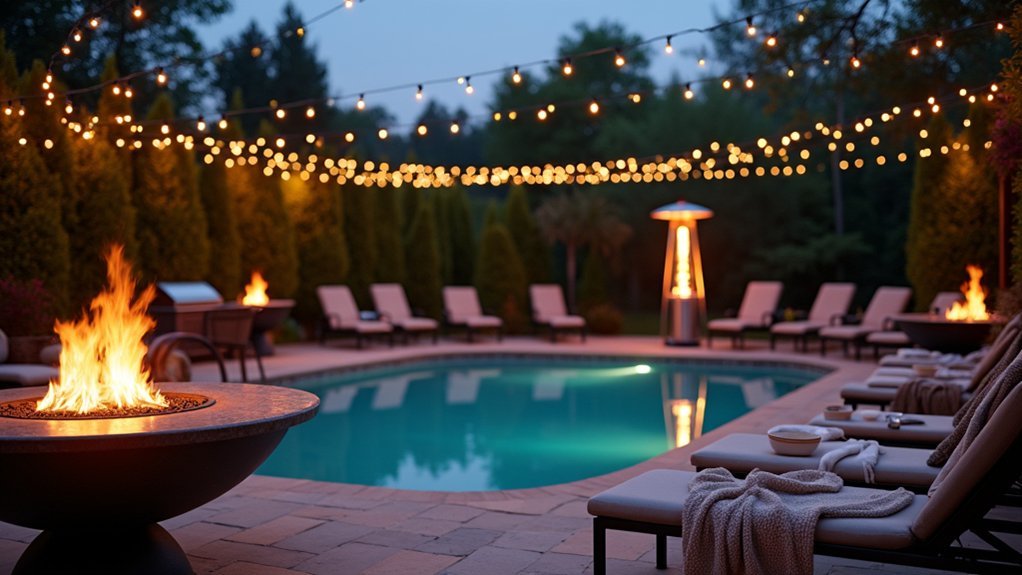You’ll want gas-powered patio heaters with 40,000+ BTU output for pool entertainment, as they create comfortable 20-foot diameter zones perfect for guests shifting from warm water to cool air. Electric heaters offer safer operation around water but produce only 5,100 BTUs, limiting their effectiveness for larger gatherings. Mushroom-style gas heaters work best poolside, providing infrared warmth that directly heats people rather than air. Strategic positioning and weather-resistant features guarantee your outdoor space remains inviting year-round.
Electric Patio Heaters for Poolside Safety and Convenience

When you’re hosting poolside gatherings, electric patio heaters offer the perfect blend of safety and convenience for your outdoor entertainment needs.
Electric patio heaters provide the ideal combination of safety and convenience for poolside entertaining and outdoor gatherings.
You’ll appreciate their simple plug-in installation, eliminating the hassle of gas lines or tanks around water areas. These heaters generate infrared heat that warms people directly, keeping your guests comfortable while they watch swimmers or socialize nearby.
Their weatherproof design makes them ideal for poolside use, functioning safely even in wet conditions.
You’ll find their moderate heat output of around 5,100 BTUs perfect for intimate gatherings without creating overwhelming warmth.
With remote controls and adjustable heat settings, electric patio heaters deliver customizable comfort that enhances your poolside entertainment experience while maintaining the safety standards essential around water features.
Gas-Powered Heating Solutions for Maximum Warmth Output
When you’re choosing gas-powered heaters for your pool area, you’ll need to evaluate whether natural gas installation with dedicated gas lines fits your setup or if propane’s portable tank system works better for your space.
You’ll also want to compare BTU outputs between different models, as gas heaters typically deliver 30,000 to 50,000 BTUs for maximum warmth coverage.
Keep in mind that propane requires regular tank refills and maintenance, while natural gas provides continuous fuel supply once you’ve completed the initial installation.
Natural Gas Installation Requirements
Since natural gas patio heaters offer continuous fuel supply without tank replacements, you’ll need to install a dedicated gas line to power these units effectively. This installation requires professional assistance to guarantee safety compliance with local codes. The process typically involves trenching for the gas line and connecting to your existing gas supply system.
- No more midnight propane runs – enjoy uninterrupted warmth during those perfect poolside gatherings
- Professional peace of mind – expert installation eliminates dangerous gas leaks that could threaten your family
- Permit paperwork handled – avoid costly code violations and potential insurance nightmares
While natural gas heaters produce less heat than propane models, they’re ideal for consistent outdoor heating solutions.
Consider installation costs and required permits when planning your pool entertainment area’s heating system.
Propane Tank Maintenance Needs
Propane heaters deliver superior heat output compared to their natural gas counterparts, but this power comes with hands-on maintenance responsibilities you can’t ignore.
Your propane tank requires monthly leak inspections using soapy water solution—bubbles indicate dangerous gas leakage that demands immediate attention. Store tanks in cool, ventilated areas away from direct sunlight to prevent hazardous pressure buildup.
Replace regulators and connecting hoses regularly since worn components create safety risks and reduce heating efficiency.
Never overfill your propane tank beyond 80% capacity, as gas expansion can cause dangerous leaks. Always close the tank valve completely when your propane heaters aren’t operating.
These maintenance steps aren’t optional—they’re essential safety protocols that protect your family while ensuring peak performance during pool entertainment sessions.
BTU Output Comparisons
While propane and natural gas heaters both excel at poolside warming, their BTU output tell dramatically different performance stories.
Gas patio heaters typically deliver 30,000 to 50,000 BTUs, with propane heater models often producing higher outputs than natural gas alternatives. This increased BTU output translates directly to superior heating efficiency for your outdoor space.
A 40,000 BTU unit effectively warms a 10-foot radius, perfect for poolside gatherings.
You’ll need to calculate your area’s cubic footage and desired temperature increase to select the right heater size.
- Feel the instant warmth enveloping your guests as powerful BTUs transform chilly evenings into cozy memories
- Experience the confidence of choosing equipment that won’t leave anyone shivering poolside
- Enjoy extended outdoor entertaining seasons with professional-grade heating performance
Choose heaters with heat reflectors to maximize BTU distribution and warmth coverage.
Radiant Heat Technology Vs Traditional Heating Methods
When you’re choosing between radiant heat technology and traditional heating methods for your poolside entertainment area, you’ll discover that radiant heaters deliver infrared warmth directly to objects and people rather than wasting energy heating the air around you.
Traditional forced air systems struggle with efficiency in open outdoor spaces, losing heat quickly and taking longer to generate noticeable warmth.
Your outdoor heater using radiant technology can warm designated areas within minutes while providing efficient heating that reduces energy consumption by up to 30% compared to conventional methods.
Radiant outdoor heaters deliver instant warmth to targeted areas while cutting energy costs by up to 30% versus traditional heating methods.
This makes radiant heating a cost-effective choice for extended outdoor use, focusing heat precisely where you need it most for enhanced spectator and grilling comfort.
Positioning and Installation Considerations Around Pool Areas

Three critical factors determine successful heater placement around your pool area: safety clearances, heat distribution patterns, and local building codes.
You’ll need to position outdoor heaters at least 3 feet from your swimming pool’s edge to comply with safety regulations and prevent electrical hazards. Propane gas heaters offer excellent positioning flexibility, allowing you to relocate them based on wind conditions and guest comfort.
Consider these strategic placement options:
- Mushroom head heaters – Perfect for creating cozy gathering spots where swimmers and loungers can warm up together
- Mounted units above the pool – Maximize your deck space while delivering overhead warmth without blocking stunning water views
- Portable LP heaters – Adapt instantly to changing weather conditions and party layouts
Calculate required BTUs based on your pool area’s size and desired temperature increase for ideal heat coverage.
Weather-Resistant Features for Year-Round Pool Entertainment
Since unpredictable weather shouldn’t derail your poolside entertaining plans, investing in heaters with robust weather-resistant features becomes crucial for maintaining year-round comfort. Weather-resistant outdoor heaters incorporate waterproof materials that protect against rain and snow, greatly extending their operational lifespan.
| Feature | Benefit |
|---|---|
| Waterproof Design | Protects internal components from moisture damage |
| Durable Materials | Withstands harsh weather conditions effectively |
| Tip-Over Protection | Prevents accidents during windy conditions |
| Protective Covers | Enables safe storage between uses |
| Infrared Technology | Provides immediate warmth regardless of temperature |
These safety features make sure you can confidently use your poolside heating system throughout different seasons. Portable models with extensive weather protection offer flexibility while maintaining durability, making them perfect for year-round pool entertainment.
BTU Requirements and Coverage Areas for Pool Spaces

While weather-resistant features protect your investment, selecting the right heating power determines whether your guests stay comfortable throughout their poolside gathering. Understanding BTU requirements guarantees you’ll create the perfect comfortable outdoor space for entertaining.
Understanding BTU requirements is the key to creating a perfectly heated outdoor entertainment space for your guests.
Most outdoor patio heaters produce 30,000 to 50,000 BTUs, effectively warming 20 to 30 square feet. Calculate your needs by multiplying your space’s cubic footage by the desired temperature increase. For larger coverage areas, you’ll need multiple units—simply divide total BTUs required by each heater’s output.
Mushroom head heaters work exceptionally well for pools, providing warmth across 20-foot diameters. Strategic placement around seating and gathering spots maximizes guest comfort.
- Never watch guests shiver again during evening pool parties
- Transform chilly nights into cozy entertainment opportunities
- Create unforgettable memories in your perfectly heated outdoor oasis
Frequently Asked Questions
What Is the Best Type of Heater for a Swimming Pool?
You’ll find heat pumps work best for most pools since they’re energy-efficient and cost-effective long-term. If you need quick heating, choose gas heaters, but they’ll cost more to operate daily.
What Is the Best Way to Heat an Outdoor Swimming Pool?
You’ll get the best results combining a solar pool cover with a heat pump for moderate climates or a gas heater for rapid warming, while maintaining proper water chemistry year-round.
What Is the Best Pool Heating System?
You’ll find heat pumps work best for most situations since they’re energy-efficient and cost-effective in moderate climates. However, if you need rapid heating, gas heaters provide quicker warm-up times.
Do Outdoor Patio Heaters Really Work?
Yes, outdoor patio heaters really work. They’ll effectively warm you and nearby objects using radiant heating technology, making poolside gatherings comfortable even when temperatures drop considerably outside.





Leave a Reply